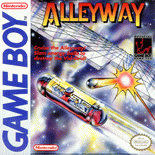
































Alleyway

Alleyway is a video game developed by Nintendo and Intelligent Systems and published by Nintendo as a global launch title for the Game Boy. It is a Breakout clone and one of the first four games developed and released for the system. The game was released first in Japan in 1989, in North America later that year, and in Europe in 1990. It was later re-released via online distribution for the Nintendo 3DS Virtual Console on June 6, 2011.
The name Alleyway references the in-game gateway that the player's spaceship (represented as a paddle) must pass through. While Alleyway is a portable clone of Breakout, it adds several new features, including alternating stages, bonus rounds, and hazards for the player at later levels.
While the game's original box art featured an unidentifiable protagonist, later international releases of the game replaced the character with Mario. Alleyway was released with limited advertising, receiving moderate to low scores from reviewers who compared it to games like Arkanoid.
The player's objective in Alleyway is to destroy all breakable bricks in each stage using a ball and paddle while keeping the ball from falling into the pit below, similar to that of Breakout. The paddle's speed can be adjusted by holding either the B or A button on the controller while moving the paddle, which can move only horizontally at a fixed height. At the start of each life, the player can reposition the paddle before releasing the ball and commencing gameplay. When released, the ball will always begin at a 45° angle above the paddle aimed toward its center. The player starts the game with five paddles; each time the ball falls into the pit below the paddle, a paddle is removed and the ball is reset.
The game ends when all the player's paddles are depleted. An additional paddle is granted for each 1000 points scored, until the player has over 10,000 points. The player may have up to nine paddles at once. The game lacks a continue feature, though the high score will be retained until the game is reset or turned off. As there is no battery-backed SaveRAM or password feature, Alleyway can only be completed in one sitting on the Game Boy. This was later changed with the re-release of the game for the Nintendo 3DS's Virtual Console system, which allowed for in-game progress to be recorded to a single save state accessible at any time while playing the game.
The ball will only travel at 15°, 30°, or 45° angles. If the ball hits a brick, the brick disappears and the ball ricochets in a different direction at the same angle. The ball's speed depends on the type of brick that it hits: gray and black bricks increase its speed, while white and square, indestructible bricks have no effect. A sound effect is also played when the ball collides with an object or wall, with walls producing the lowest pitch and black bricks the highest.
The ball's direction and speed can be controlled by the paddle's velocity and point of contact. Changing direction the moment the ball comes into contact with the paddle, called a snap technique, will bounce the ball upward with increased speed. Moving the paddle quickly in the opposite direction than the ball is headed will result in the ball bouncing in the same horizontal direction as the paddle at a 15° angle. If the player contacts the ball with the body of the paddle before it falls into the pit below, it will bounce back into the playing field. However, if instead either corner of the paddle collides with the ball at that moment, it will be knocked directly into the pit.
Alleyway's ball cannot be locked in an infinite loop of ricochets. Whenever the ball starts to loop between objects such as the ceiling, indestructible blocks and/or the paddle itself, its velocity will change at a random point after the second cycle on its next collision. As a result, the ball will travel at a slightly raised or lowered angle depending on its current trajectory, and will break out of the loop.
How to play:
Click on the joystick icon in the Alleyway online emulator to see how to control the Alleyway game









































Comments